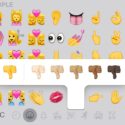Males and females use language in different ways. Just as speech varies by gender, so do writing conventions. For example, males tend to prescind punctuation (especially the sentence-ending period and all those troublesome apostrophes) when writing in unregulated settings, whereas females tend to preserve punctuation. Females use more ellipses and exclamation marks.
Anecdotally speaking, it seems that females use emoticons more often than males (myself notwithstanding). Indeed, the presence of an emoticon in an unidentified piece of text is likely to be interpreted as a sign that the writer is likely female. But there are plenty of guys who use them. What’s the story?
Witmer & Katzman studied this back in 1997, and they concluded that, yes, females employ emoticons more frequently than males. A few years later, Wolf (2000), asserted that females don’t necessarily use them more often, but the genders do use them in different ways: Whereas females use emoticons mostly to indicate solidarity, males are more likely to use them for sarcasm.
But as emoticons have flowered from typographical arrangements to pre-built emoji, perhaps this research should be updated. Moreover, there’s plenty of stuff left to look into: In what environments do people use emoticons more, and do we see gender differences? (“Environments” here can mean both conversational situations and syntactical environments.) On what devices are people more likely to use emoticons? What about those sticker things—are people using those, and why? And let’s think globally: While findings regarding punctuation have been corroborated in multiple cultures, we haven’t yet compared emoticon habits across cultures.
Guess it’s time to get to work!
 Follow
Follow

